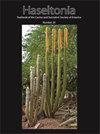仙人掌树皮形成过程中微孔的变化
IF 0.4
4区 生物学
Q2 PLANT SCIENCES
引用次数: 2
摘要
摘要:刺是仙人掌的重要组成部分。除了提供免受捕食的保护外,它们还减少热负荷,减少蒸腾作用,并有助于茎段的扩散,以供营养繁殖等。在美洲,二十多种柱状仙人掌的表面都有树皮。对于所有被测试的物种,树皮的形成都与阳光直射有关。大面积的树皮覆盖导致仙人掌(Carnegiea gigantea)过早死亡。初步证据表明,巨茶树皮形成过程中,巨茶树皮上的带刺小孔发生了变化。分析了2017年461张相邻槽上具有树皮百分比的嫩芽南北面微孔的成对摄影图像,以确定南北面差异。与过去的研究一样,朝南表面的树皮百分比(平均树皮覆盖率62%)高于朝北表面(平均树皮覆盖率19%)。北、南两个区域的中心棘数平均为2.70/1.55;桡骨棘3.20/1.50;和先端棘分别为1.81/1.13。当将数据汇总比较中央、径向和先端棘的数量以及棘的颜色和棘的厚度时,所有数据都与树皮百分比显著相关。在邻近的沟槽上,刺的数量和特征在树皮形成之前就减少了。总的来说,结果表明波峰比相邻的波谷恶化得更快。据我们所知,这是第一份记录仙人掌物种的棘数和特征随树皮覆盖变化的报告。本文章由计算机程序翻译,如有差异,请以英文原文为准。
Areole Changes during Bark Formation on Saguaro Cacti
Abstract: Spines are an important component of cactus species. Besides providing protection from predation, they reduce heat loading, reduce transpiration, and aid dispersal of stem segments for vegetative propagation among others. Bark formation occurs on surfaces of more than twenty species of columnar cacti in the Americas. For all species tested, bark formation is related to direct sunlight exposure. Extensive bark coverage leads to premature death for saguaro cacti (Carnegiea gigantea). Preliminary evidence indicates that changes in areoles with spines occurred during the bark formation on C. gigantea. Four hundred, sixty-one paired photographic images of areoles of north- and south-facing surfaces of shoots with bark percentages on adjacent troughs in 2017 were analyzed to determine differences between north- and south-facing surfaces. As in past studies, south-facing surfaces had higher bark percentages (mean bark coverage 62%) than north-facing surfaces (mean bark coverage 19%). For north and south areoles, mean numbers of central spines were 2.70/1.55; radial spines 3.20/1.50; and apex spines 1.81/1.13, respectively. When data were pooled to compare numbers of central, radial and apex spines as well as spine color and spine thickness, all were significantly related with bark percentages. Decreases in numbers and characteristics of spines precede bark formation on adjacent troughs. Overall, the results show that crests deteriorate faster than adjacent troughs. To our knowledge, this is the first report to document changes in spine numbers and characteristics with bark coverage on a cactus species.
求助全文
通过发布文献求助,成功后即可免费获取论文全文。
去求助
来源期刊

Haseltonia
生物-植物科学
CiteScore
3.00
自引率
6.70%
发文量
11
审稿时长
>12 weeks
期刊介绍:
Haseltonia, Yearbook of the Cactus and Succulent Society of America, is published in full color and features peer-reviewed articles about all aspects of cacti, succulents and their environs. Topics include current research and conservation reports, new species descriptions and lengthy taxonomic revisions, historical and biographical notes, chemical and cytological studies, evolutionary biology and ethnobotanical reports, propagation and pest control methods, and pollinator studies. Serious students of the world''s succulent flora, botanists, taxonomists, researchers and horticulturalists will all find Haseltonia a valuable addition to their book collection.
 求助内容:
求助内容: 应助结果提醒方式:
应助结果提醒方式:


